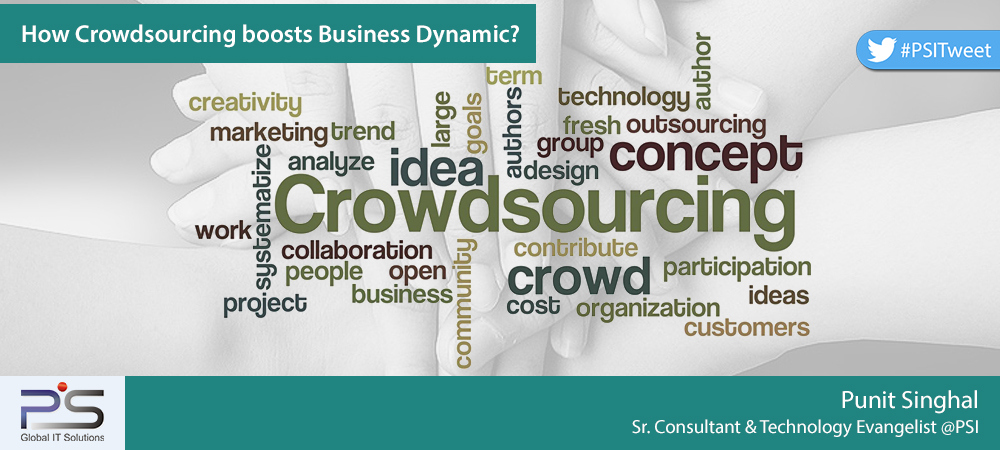
What is Crowdsourcing?
Explicitly speaking, Crowdsourcing implies ‘many heads are better than one’. The most evident example we can see today is Wikipedia. It is an encyclopaedia that everyone quotes today and refers to for any debate, discussion or justification. With this mechanism it is believed that when many people contribute, automatically the quality of content enhances and chances of errors reduces.
Initially when crowdsourcing term was coined, it meant a method through which an organisation outsources to a network/arrangement of people by an open invitation. The requesting party floats a work request; the crowd can participate, perform the task at hand and get reimbursed for the services.
IT industry walled by economic uncertainty and challenging global business scenario is propelled to look out for new avenues of designing and delivering the software services. Customers are always on a look out for innovation and outcome based models for business activities. They demand improved levels of productivity at lower costs and higher quality outputs.
For instance, IBM’s Smarter ADM concept, highly rated amongst the competitor’s strategies is based on crowdsourcing model only.
What are the key aspects and relevance for the Software community?
- Network of communities: Unlike the traditional model, virtual teams are developed based on the collaboration for deliverables facilitated by social technologies. The leaders govern and manage the deliverables.
- Digital reputation:The team members list their accomplishments based on turn-around time, speed, quality, etc.
- Performance based maturity: Analytics are applied for tracking performance on various aspects of delivery model.
- Transparency: The members must be kept in loop of all major developments in the project and establish knowledge sharing among them.
- Best practices: A repository of acceptable practices is prepared for the team to be referred and followed. This will help reinforce the business customs.
Crowdsourcing with and without organisational boundaries are both possible and successful in current scenario.
What are the factors determining the success rate?
The factors affecting the success rate of this business model are, strong business need, social networks and enthusiastic talent pool.
It helps organisations address the basic IT challenges of the ever changing product requirements by the client and the market landscape w.r.t the supply-demand ratios.
Crowdsourcing is a social business model; reaping the benefits of internet to harness the efforts of virtual crowd based teams to achieve specific work deliverables. It is both disruptive and effective at the same time. The highlights are namely, access to global talent and cost effectiveness.
How do we utilise Crowdsourcing for Business Dynamics?
Employing Crowdsourcing for a project depends on the idea that the software product is trying to solve. The major aspects to be considered while approaching Crowdsourcing are:
- Adequate interest and motivation in community to participate.
- The solution should be highly modular so that it can be scalable.
- The solution should have low granularity to allow low-effort participation.
Knowledge and acceptance of the collaborative business practices is necessary for top management to adapt and embrace the new opportunities. The process flow for a crowdsource based development is:
- Specify the requirements: The technical, functional, and usage requirements are to be predefined.
- Understand the roadmap: The major challenge is to have a detailed roadmap and specific timelines attached to the different tasks at hand.
- Budgeting: The cost depends on numerous factors be it product design, complexity, integrations and other aspects.
- Feedback: Regular feedback throughout the process is essential for successful completion of the project falling within the constraints of time and money.
Crowdsourcing improves the speed, innovation level and quality of the development across industries and projects. It helps businesses to gain that competitive advantage mainly pertaining to costs, skills and agility.
Image Courtesy: crowdsourcingweek.comWhat is Crowdsourcing?
Explicitly speaking, Crowdsourcing implies ‘many heads are better than one’. The most evident example we can see today is Wikipedia. It is an encyclopaedia that everyone quotes today and refers to for any debate, discussion or justification. With this mechanism it is believed that when many people contribute, automatically the quality of content enhances and chances of errors reduces.
Initially when crowdsourcing term was coined, it meant a method through which an organisation outsources to a network/arrangement of people by an open invitation. The requesting party floats a work request; the crowd can participate, perform the task at hand and get reimbursed for the services.
IT industry walled by economic uncertainty and challenging global business scenario is propelled to look out for new avenues of designing and delivering the software services. Customers are always on a look out for innovation and outcome based models for business activities. They demand improved levels of productivity at lower costs and higher quality outputs.
For instance, IBM’s Smarter ADM concept, highly rated amongst the competitor’s strategies is based on crowdsourcing model only.
What are the key aspects and relevance for the Software community?
- Network of communities: Unlike the traditional model, virtual teams are developed based on the collaboration for deliverables facilitated by social technologies. The leaders govern and manage the deliverables.
- Digital reputation:The team members list their accomplishments based on turn-around time, speed, quality, etc.
- Performance based maturity: Analytics are applied for tracking performance on various aspects of delivery model.
- Transparency: The members must be kept in loop of all major developments in the project and establish knowledge sharing among them.
- Best practices: A repository of acceptable practices is prepared for the team to be referred and followed. This will help reinforce the business customs.
Crowdsourcing with and without organisational boundaries are both possible and successful in current scenario.
What are the factors determining the success rate?
The factors affecting the success rate of this business model are, strong business need, social networks and enthusiastic talent pool.
It helps organisations address the basic IT challenges of the ever changing product requirements by the client and the market landscape w.r.t the supply-demand ratios.
Crowdsourcing is a social business model; reaping the benefits of internet to harness the efforts of virtual crowd based teams to achieve specific work deliverables. It is both disruptive and effective at the same time. The highlights are namely, access to global talent and cost effectiveness.
How do we utilise Crowdsourcing for Business Dynamics?
Employing Crowdsourcing for a project depends on the idea that the software product is trying to solve. The major aspects to be considered while approaching Crowdsourcing are:
- Adequate interest and motivation in community to participate.
- The solution should be highly modular so that it can be scalable.
- The solution should have low granularity to allow low-effort participation.
Knowledge and acceptance of the collaborative business practices is necessary for top management to adapt and embrace the new opportunities.
The process flow for a crowdsource based development is:
- Specify the requirements: The technical, functional, and usage requirements are to be predefined.
- Understand the roadmap: The major challenge is to have a detailed roadmap and specific timelines attached to the different tasks at hand.
- Budgeting: The cost depends on numerous factors be it product design, complexity, integrations and other aspects.
- Feedback: Regular feedback throughout the process is essential for successful completion of the project falling within the constraints of time and money.
Crowdsourcing improves the speed, innovation level and quality of the development across industries and projects. It helps businesses to gain that competitive advantage mainly pertaining to costs, skills and agility.
Image Courtesy: crowdsourcingweek.com[:]








